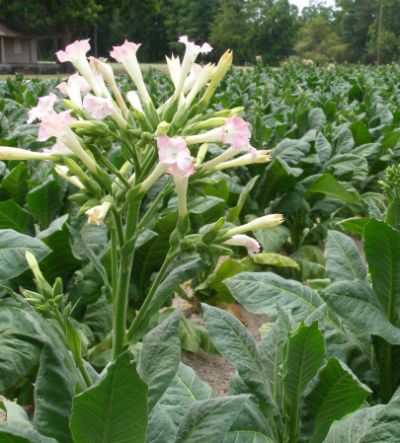“Tobacco’s first encounter with Europe was in the palace gardens in Spain and Portugal, from where it spread to the rest of the continent, first because of its beauty, and later because of the medical properties that were assigned to it.” ~Katarina
 Tobacco’s genus, Nicotiana, covers over 70 species. The name tobacco usually refers to most famous and widely used Nicotiana Tabacum and its shorter but more potent cousin Nicotiana Rustica, both native to the Americas.
Tobacco’s genus, Nicotiana, covers over 70 species. The name tobacco usually refers to most famous and widely used Nicotiana Tabacum and its shorter but more potent cousin Nicotiana Rustica, both native to the Americas.
Although it’s hard to pinpoint when and where it was first cultivated, it is sure tobacco has been used for several thousand years before the time Christopher Columbus reached Americas in 1492, and after that it spread to the whole world.
Although in present-day society associated with a myriad of health issues, including cancer and cardiovascular diseases, this plant has been used for medicinal, as well as ritual purposes for millennia. Only in the last decades tobacco has been aggressively proclaimed harmful. Up until the ‘50s they even had doctors promoting them. Why it is so?
Throughout South and North America, tobacco was used consumed in a diversity of ways: it was chewed, sniffed, smoked, eaten, juiced, smeared over bodies, and used in eye drops and enemas. Its use varied depending on the culture and location – it ranged from medicinal as a remedy for many ailments, to purely recreational consumed by both men and women, and also mystical – a connection to the spiritual world: it´s purifying smoke was blown over fields before planting, over women prior to sex, blown into warriors’ faces before battle, it was offered to gods as well as accepted as their gift. In other words, tobacco smoke was believed to carry blessings, protection and most of all purification.
The popularity of tobacco was likely due to its dual nature: small amounts of tobacco produce a mild stimulating effect on the user, while large amounts can cause hallucinations, deep trance or even death. This is why it plays a major role in many shamanistic traditions, and is an integral part of many of their cultures.
Even today it is widely used by shamans in the Amazon, where shamans who specialize in ceremonies with tobacco are called tabaqueros. They master the spirit of tobacco and heal illnesses with his/her blow of tobacco. There tobacco is considered a Planta Maestra, i.e. Teacher Plant. These plants are considered key protective spirits, allies and guides to the world of health and healing. Other examples of Teacher Plants are Ayahuasca, San Pedro and Coca, but there are dozen others, not necessarily hallucinogenic.
In pre-Columbian North America, different tribes and civilizations had used tobacco, with one thing in common – they all preferred pipes for smoking. The pipes were utilized for distinct social and ritual purposes, which resulted in their sacred status, same as tobacco itself had. Various tribes used tobacco for various purposes including healing ailments such as earaches, snake bites, cuts and burns, respiratory diseases, fever, convulsions, nervous ailments, urinary ailments, and skin diseases. Other examples of its use was sealing the peace with other tribes, preventing lightning and storms, communicating with spirits and, making an offering to them.
Tobacco’s first encounter with Europe was in the palace gardens in Spain and Portugal, from where it spread to the rest of the continent, first because of its beauty, and later because of the medical properties that were assigned to it. The first noted experiments with the plant were conducted by Jean Nicot, a French ambassador in Portugal, after whom nicotine was later named. He succeeded to cure a man with a tumor applying tobacco poultices, and continued experimenting with it. He introduced the plant to the French court and promoted its medicinal properties, which gave a boost to its popularity.
The popularity of tobacco is likely owed to nicotine, one of its potent ingredients. Nicotine is an alkaloid that in lesser doses produces a relaxing and stimulating effect, and increases the level of dopamine and serotonin, which probably accounts for its addictive properties. In higher doses it can be harmful. Even though labeled addictive, its benefits seem to outweigh the risks. In fact, it seems to have no more health risks than caffeine.
The confusion about nicotine comes from anti-smoking activists who equate nicotine and smoking. Nicotine is an anti-inflammatory agent and has been shown, among other things to prevent and treat Alzheimer’s, as well as delay the onset of Parkinson’s disease.
Analysis of natural tobacco leaf has been shown to contain more than 3,000 endogenous plant organic and inorganic chemical compounds. Interestingly, among them are certain harmala alkaloids, which perform as monoamine oxidase inhibitors (MAOI-s). These prevent the breakdown of monoamine neurotransmitters such as dopamine and serotonin and thereby increase their availability. This can also account for tobacco’s “feel good” effect. Also, in case of ingesting DMT, tobacco is likely to increase its absorption.
What happened in the last hundred years that changed the way the world thinks about tobacco?
At the notion of tobacco, the majority of people will associate it with disease. The WHO states that “tobacco use is one of the biggest public health threats the world has ever faced”. This statement is false because the tobacco itself doesn’t present such a health threat; it is the modern tobacco products and the production process that pose a threat.
Continue reading here
